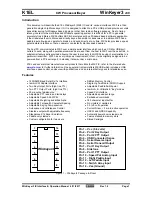
23
Electrical Noise
In general, electrical noise can be divided into two forms: wire-borne
electromagnetic interference (EMI), and radiating radio frequency
interference (RFI).
Using shielded motor cables reduces RFI but increases EMI. This is
because shielded wires have a greater capacitance than unshielded
wires. Unshielded input power connections to the drive generate more
noise in the radio frequency range on the AC line. The shield reduces
the radiated noise, but increases the low-frequency electromagnetic
noise on the AC line. But, since the noise current is taken back to the
unit through the shield, only a small electromagnetic field is generated
from shielded motor wires.
With an EMI filter, the noise level on the AC line will be reduced to about
the same level for shielded and unshielded wires alike.
Connect the motor wiring shield, if used, in the enclosure of the drive as
well as at the motor. Use shield brackets to avoid pigtail shield ends.
Even short pigtails increase the shields impedance at higher
frequencies, which reduces the shields effect and increases the noise
produced.
It is generally easier and less complicated to use unshielded motor
wires than shielded cables. If unshielded wires are used, the RFI will
be greater. But, since the strength of the radiated signal decreases with
distance from the signal source, radiated noise is generally not a
problem.
To reduce the noise level from the total system (drive + installation)
make the motor wiring as short as possible.
Provide separate conduits, or raceways, for power, motor and control
wiring to provide the greatest immunity from distortion.
Galvanic Isolation
Galvanic isolation offers protection from electric shock. All control
terminals of all TR1 drives, and terminals 1 through 3 of the relay
output, offer galvanic isolation. The galvanic isolation in the TR1
conforms to the European standard EN 50178. (See figure below.)
The components that make up the galvanic isolation are:
1. Power supply, including signal isolation.
2. Gate drive for the IGBTs, the trigger transformers and opto-
couplers.
3. The output current Hall effect transducers.
Extra Safety Protection
Residual Current Device (RCD) relays for ground fault protection, or
multiple protective grounding, can be used as extra safety protection,
provided that local safety regulations are complied with. In case of a
grounding fault, the fault current may contain a DC component. If RCD
relays, also known as Earth Leakage Circuit Breakers (ELCB), are
used, they may be suitable for protection of 3-phase equipment with a
bridge rectifier and for a brief current surge at power-up.
Since leakage current is greater than 3.5 mA, reinforced grounding
must be provided if compliance with EN 50178 is required. The relays
must be suitable to meet the following requirements:
1) protecting equipment with a DC content (Din VDE 0664) in the fault
current (3-phase rectifier)
2) power-up with short pulse-shaped charging current to ground
3) high leakage currents
RCD fault relays type B comply with these requirements according to
the norm IEC 755-2.
Galvanic Isolation
















































